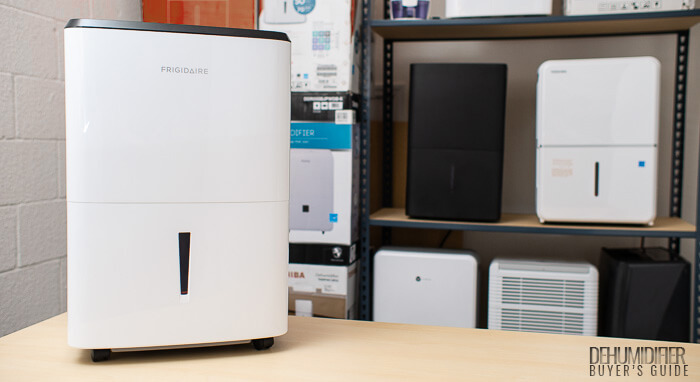
- A top performer in our moisture removal tests
- Excellent energy efficiency
- A pleasing noise output profile due to low compressor noise and an upward facing high CFM exhaust
- Excellent build quality compared to that of most other compressor based dehumidifiers we’ve tested
- Improved low temperature operation – competitors require a “defrost mode” to defrost evaporator coils at lower temperatures. On this mode such units stop dehumidifying and only have their fan running for a set period of time. The FFAD5033W1 has an optimized refrigeration system that automatically defrosts evaporator coils without the need of this separate energy inefficient mode.
- Only comes with a 1 year warranty
- Dehumidifier
- Instruction Manual
| Energy Efficiency | 5.0 |
| Noise Output | 4.5 |
| Moisture Removal | 5.0 |
| Hygrometer Accuracy | 4.5 |
| Durability | 5.0 |
| Adjustability | 4.5 |
| Versatility | 4.5 |
| Extra Features | 4.0 |
| Ease of Use | 5.0 |
| Portability | 4.5 |
| Warranty | 3.5 |
| Value | 5.0 |
| Editor's Score | 4.7 |
2024 Update
Frigidaire released a very minor update to the FFAD5033W1 this past year – the FFAD5034W1. The older FFAD5033W1 (left below) is sold as a “50 pint” unit and the new FFAD5034W1 (right below) is sold as a “50 Pint New 2024” unit.
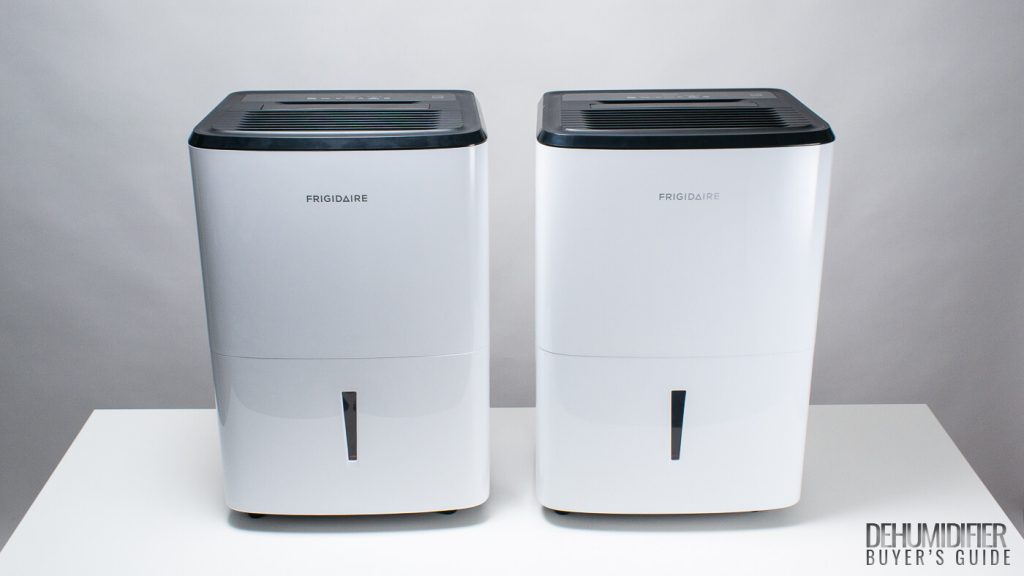
We bought and tested the new FFAD5034W1 in early 2024, and our testing showed very little difference in performance between it and the older FFAD5033W1.
The new model didn’t remove moisture any more quickly in our moisture removal tests and it didn’t produce any less noise in our noise output testing.
The only test in which we saw a minor improvement in performance was our energy test. The older FFAD5033W1 drew 570 watts, while the new FFAD5034W1 drew 560 watts of power in this test.
Otherwise, the new FFAD5034W1 is essentially identical to the FFAD5033W1. If you want to buy a Frigidaire 50 pint unit, we recommend buying whichever model is cheaper at this time.
Check the FFAD5033W1’s current pricing.
Check the FFAD5034W1’s current pricing.
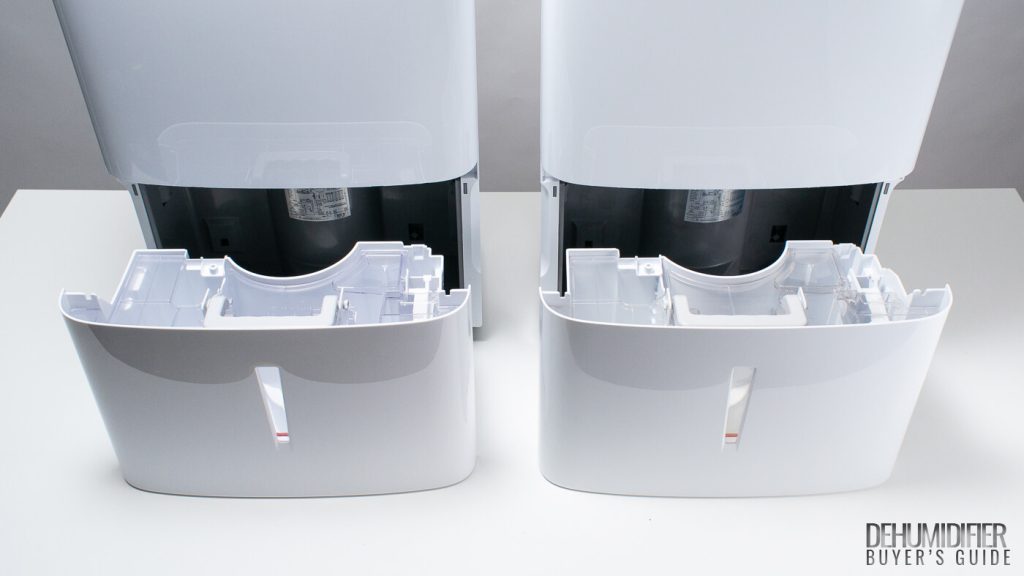
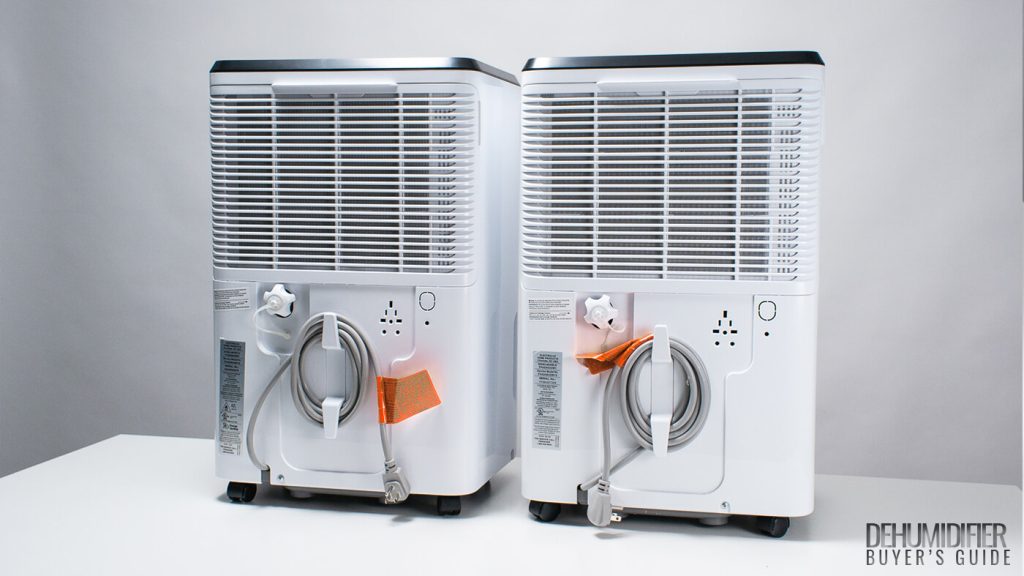
Performance Test Results
Energy Efficiency
At Extreme Humidity
The FFAD5033W1 has a manufacturer specified power draw of 7.8 amps (897 watts). This falls in the upper end of the range for 50 pint dehumidifiers. The Hisense DH7019K1G (7.8 amps = 897 watts) and Toshiba TDDP5012ES2 (7.8 amps = 897 watts) are a few other examples of units that fall in the upper end of the range. The LG UD501KOG5 (6.3 amps = 725 watts) and hOmeLabs HME020031N (6.5 amps = 745 watts) are some examples of units that fall in the lower end of the range.
Our own testing revealed all of these units to have a similar power draw of approx. 760 watts at extreme humidity levels (close to 100% RH). This, of course, is less than the 897 watts the FFAD5033W1 is rated for, suggesting that the manufacturer specification either…
a. involves running the dehumidifier in even more extreme conditions than what we can emulate in our own “extreme humidity” testing or
b. is more of a guideline for safe use. Remember, all manufacturer specifications are given in amps. We calculated the watts listed above by multiplying the given amperage by 115 (volts). It’s not unreasonable to believe manufacturers are giving power draw in amps simply so that you can estimate safe use of their appliance on a 15 amp circuit. By erring on the side of caution and specifying a slightly inflated amperage, the manufacturer is allowing for more safe use of their appliance.
At Moderate Humidity
We also measured power draw at a more moderate humidity level (right around 50% relative humidity).
In these conditions, we saw two things:
First, we saw a lot more variance in tested wattage between different models. Recall that all of the 50 pint units we tested had approximately the same power draw of 760 watts in our “extreme humidity” testing. In more moderate conditions they did not all have the same power draw.
Second, we found all units to draw much less power at 50% RH than they did at higher humidity levels. This was expected, as a dehumidifier’s power draw is directly proportional to how hard it has to work to dehumidify. At close to 100% RH it has to work a lot harder than at 50% RH.
In our moderate humidity testing the Frigidaire drew only 570 watts of power at 50% RH. The Hisense drew 597 watts and the Toshiba drew 578 watts. Surprisingly, those units with a lower manufacturer specified amperage drew more power at 50% RH. The LG drew 586 watts and the hOmeLabs drew 610 watts.
Thus, at more moderate humidity levels, the Frigidaire was one of the least power hungry dehumidifiers we tested. Among the ten 50 pint units we tested very recently, only the Black+Decker BDT50WTB (554 watts) and Honeywell TP70WKN (563 watts) had a lower tested power draw than the Frigidaire (570 watts).
Power Draw And Moisture Removal Rate In Determining Energy Efficiency
Dehumidifier energy efficiency not only depends on raw power draw, but it also very much depends on how long it takes the dehumidifier to remove moisture from the air.
If two dehumidifiers have similar power draw (such as what we saw in high humidity testing), the more energy efficient unit is the one that removes moisture faster – the one that draws that power for a shorter period of time.
This is exactly what we see with the Frigidaire. It removed moisture much faster than any other 50 pint dehumidifier we tested in our moisture removal tests. In other words, it took much less time to dehumidify a high humidity space than any other 50 pint dehumidifier we tested.
The fact that it was able to remove moisture faster at the same approx. power draw at high humidity, makes it the most energy efficient 50 pint unit we tested at high humidity.
Since it has low power draw compared to the competition and still removes moisture faster at moderate humidity, it is also the most energy efficient 50 pint unit we tested at more moderate humidity levels.
Energy Efficiency Conclusion
Assessing a dehumidifier’s energy efficiency can be a complex task. To make this assessment we take into account manufacturer specifications, our own power draw test results, and our own moisture removal rate test results. We also consider Energy Star certification. In this case, the Frigidaire FFAD5033W1 is fully Energy Star certified.
When all of this is taken into account we believe the FFAD5033W1 to be one of the most energy efficient dehumidifiers on the market.
Noise Output
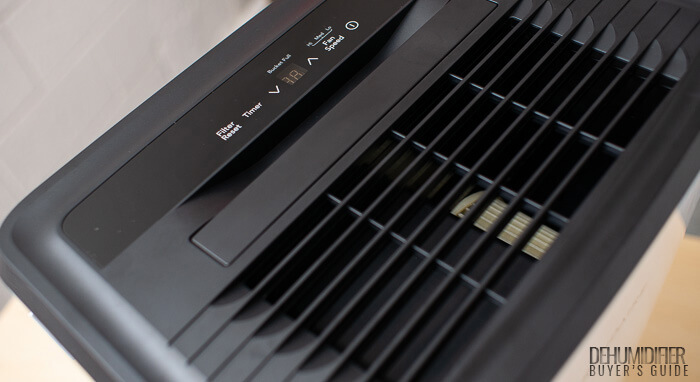
The FFAD5033W1 can get very loud, but this isn’t necessarily a bad thing. Let us explain.
Dehumidifiers primarily make two types of noise:
- Compressor noise
- Air noise generated by air moving through the dehumidifier and out through its exhaust
Compressor noise is very unpleasant to listen to. It’s the same buzzing noise you might hear in an old refrigerator.
The second noise – air noise mostly generated by air moving through the unit’s exhaust – is a much more pleasant clean noise.
We test for raw noise output. This gives us dB numbers that describe the extent of the loudness of a dehumidifier but not the quality of that loudness.
The FFAD5033W1 was one of the louder dehumidifiers we’ve tested. Its tested noise output, measured right next to the dehumidifier’s control panel, was 70.2 dB on high fan speed and 64.8 dB on low fan speed. Measured 10 ft. away from the dehumidifier it was 54.6 dB on high fan speed and 49.8 dB on low fan speed.
For comparison, the very “quiet” hOmeLabs HME020031N garnered the following results in the same tests: 59.3 dB (control panel high fan), 58.6 dB (control panel low fan), 50.3 dB (10 ft. high fan), and 48.8 dB (10 ft. low fan). These are clearly lower raw dB numbers than those of the Frigidaire.
Still, we consider the hOmeLabs the “noisier” dehumidifier.
Why? Because of its noise output profile (i.e. the quality of the noise it produces).
The hOmeLabs has a louder compressor, a lower CFM fan, and it exhausts through its side. This results in lower raw dB numbers but a much more unpleasant noise output profile because the air noise generated by its fan doesn’t completely mask its compressor noise.
The Frigidaire has a quieter compressor, a higher CFM fan, and it exhausts through the top of the dehumidifier. All of these factors contribute to allow the dehumidifier’s fan noise to completely mask its compressor noise on high fan speed.
The end result is that the Frigidaire has one of the best (the most pleasing sounding) noise output profiles of any high capacity dehumidifier on the market. Is it the quietest from a technical standpoint (by looking at raw dB numbers)? No, it’s not.
But we think you’ll much prefer the sound of this “louder” dehumidifier operating in a room over many of the more “quiet” options out there.
Moisture Removal
Our moisture removal rate tests are perhaps the most important tests we perform. You’re buying a dehumidifier to dehumidify. And the faster it does it the better. These tests show which dehumidifiers can dehumidify the fastest.
In the first test we measure how long it takes the dehumidifier to dehumidify a 50 sq. ft. space from 90% down to 40% relative humidity (RH). In the second test we measure how long it takes to lower room humidity from 80% down to 50% RH.
The FFAD5033W1 performed very well in both tests but it garnered especially good results in the first test. The Frigidaire took only 7 minutes, 56 seconds to lower room humidity from 90% down to 40% RH. Of the 27 high capacity dehumidifiers we’ve tested in the last 6 years, this was the best result by a full 1 minute, 25 seconds. The next best result belongs to the now discontinued Honeywell DH70W at 9 minutes, 21 seconds.
For comparison, the hOmeLabs HME020031N took 10 minutes, 3 seconds in the same test. The Black+Decker BDT50WTB took 9 minutes, 55 seconds. The worst performing unit was the LG UD501KOG5 with a time of 14 minutes, 31 seconds.
The Frigidaire also performed well in the second test (80% to 50% RH). Among non-discontinued models we’ve tested it placed second behind the Black+Decker BDT50WTB. The BDT50WTB had a time of 5 minutes, 10 seconds and the Frigidaire had a time of 5 minutes, 19 seconds. The hOmeLabs had a time of 5 minutes, 33 seconds.
Hygrometer Accuracy
The Frigidaire features a built-in hygrometer just like every other compressor based dehumidifier on the market.
This hygrometer reads the current humidity in the room.
If you manually set the dehumidifier to a room humidity of, let’s say, 60%, the dehumidifier will continue to run until its built-in hygrometer reads 60%. Once it reads 60% the dehumidifier will automatically cycle off. It will then stay off until the built-in hygrometer reads a humidity level above 60%, at which point the dehumidifier will automatically cycle back on.
Let’s say the dehumidifier’s built-in hygrometer is inaccurate by 6% – it reads room humidity to be 6% less than the actual humidity. In this case the dehumidifier would read 60% when the actual room humidity is 66% in the scenario described above. Thus, the dehumidifier would shut off well before actual room humidity was at the desired room humidity of 60%.
This is why hygrometer accuracy is important.
So, how did the Frigidaire do in our testing? Unfortunately, this is a difficult question to answer.
The problem is that the Frigidaire only displays room humidity in 5% increments. Anytime actual room humidity in our test space was a multiple of 5% the Frigidaire’s display would be accurate. For example, when room humidity was 50% the dehumidifier would display 50%. When it was 55% it would display 55%.
But when the room humidity was not a multiple of 5% it was impossible for the unit to display an accurate number. For example, when room humidity was 53% the unit would display 55% – likely rounding up. But we cannot say for sure in such an instance whether it was rounding up or not. All we could see was the display – not the internal read-out. And the display in such an instance was off by 2%. Thus, in a worst case scenario, the actual internal read-out is off by 2%. In a best case scenario the read-out is completely accurate but displays a rounded up or down number.
In any case, we consider the unit’s hygrometer to have an accuracy of ±2% because all that we could see during testing was the display, and the display was sometimes off by 2%.
Most other 50 pint units on the market display room humidity in 1% increments and so we can assess their accuracy much better. Among such units, the Honeywell TP70WKN had the most accurate built-in hygrometer with an accuracy of ±1%. The hOmeLabs’ hygrometer was inaccurate up to 3% while the Black+Decker’s hygrometer was inaccurate up to 4%.
All in all, we consider the Frigidaire’s built-in hygrometer to have above average accuracy and to be sufficiently accurate for most applications.
Included Features, Functionality, Build Quality, Warranties, and Value
Durability (Build Quality)
General Impressions
The FFAD5033W1 is one of the most well made dehumidifiers we’ve tested. Comparing it side by side within any other 50 pint dehumidifier it’s clear that the Frigidaire is built using much higher quality parts and materials.
The control panel buttons and LEDs are higher quality. The plastics used for the body are higher quality. The plastics used for the water collection bucket are thicker and higher quality. The grille and air filter are two separate higher quality pieces vs the combined grille/air filter we see on most other units. Even the brackets used to wrap the power cord around the back of the unit are higher quality. Almost every component on this Frigidaire is of a tangibly higher quality than the equivalent component on the average dehumidifier.
Consumer Feedback
At the time of this written review, this model is brand new to market. We’ll update this section of the review once consumer reviews start trickling in commenting on the long term reliability of this unit.
Overall Category Score
The FFAD5033W1’s build quality is simply a cut above every other 50 pint unit we’ve tested. For that reason alone it receives a 5/5 in the category.
Adjustability
The unit features a timer that can be set in half hour increments up to 10 hours, and 1 hour increments from 11 hours up to 24 hours. Most other timers on most other dehumidifiers feature similar adjustability. The two exceptions are units like the GE ADEL45LY that can only be set to 2 hours or 4 hours, and units like the Toshiba TDDP5012ES2 that can only be set in 1 hour increments all the way from 1 hour up to 24 hours.
The Frigidaire’s humidistat can be manually set in increments of 5%. This, again, is an industry standard. The only exception is the now discontinued Haier DE65EM that let you set the humidity in 2% increments.
The FFAD5033W1 features 3 fan speeds. Most other 50 pint dehumidifiers, including the hOmeLabs and the Black+Decker, feature only two fan speeds – normal and turbo.
The FFAD5033W1′s extra fan speed isn’t much of an advantage though as you’ll almost always want to run all of these units on only one fan speed – high fan speed – to drown out compressor noise.
Finally, the FFAD5033W1 does feature a continuous mode – again, an industry standard.
Overall Category Score
The FFAD5033W1 earns a 4.5/5 in the category.
Versatility
Set Humidity Range
The FFAD5033W1 can be manually set to a desired humidity level of 35% to 85% – again, an industry standard. Some units, like the LG UD501KOG5 and Hisense DH7019K1G do allow you to set the desired humidity level a little lower – to 30%. Others, like the Honeywell TP70WKN, allow you to set it a little higher – to 90%.
That being said, 35% to 85% should work for the vast majority of applications.
If you require a room humidity level lower than 35% RH you can simply set the Frigidaire to continuous mode. It can theoretically dehumidify all the way down to 0% RH if left on this mode.
Operating Temperature Range
Again, it’s par for the course with this Frigidaire. Its manufacturer specified operating temperature is 41° F to 89° F. This is approximately the same range as every other compressor based dehumidifier on the market.
Gravity Drainage
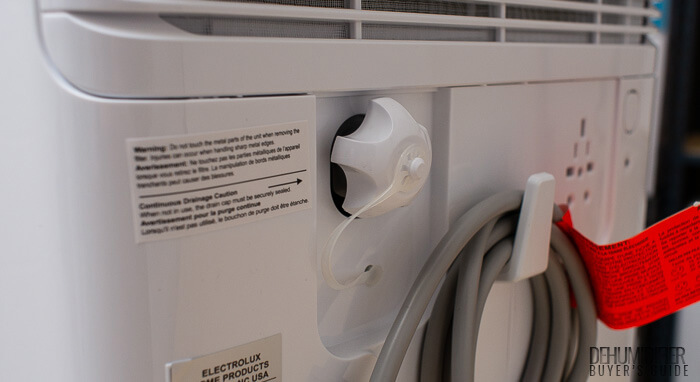
Just like every other 50 pint dehumidifier we tested, the FFAD5033W1 has a drain outlet that allows you to connect a garden hose to employ gravity drainage.
Normally, the unit will drain into its water collection bucket. But, with a drain hose connected, it will drain through that hose.
Some 50 pint models have a side drain. This Frigidaire features a back drain. Certain other models require the use of an adapter. This unit does not. There are even models (e.g. the Black+Decker BDT50WTB) that ship with a gravity drain hose. This unit does not. It requires that you supply your own garden hose to employ gravity drainage.
Built-in Pump
This unit does not feature a built-in pump. We generally do not recommend built-in pump dehumidifiers as they tend to fail within a few years of use. Check the consumer reviews of any built-in pump dehumidifier and you’ll see a slew of negative reviews complaining of early pump failure.
If you need to drain to a higher location than the dehumidifier itself (meaning you can’t use gravity drainage) we recommend the use of an external condensate pump. This option adds a bit to the cost of the dehumidifier but we believe it to be a much better option than a built-in pump dehumidifier
Overall Category Score
The Frigidaire earns a 4.5/5 in the category.
Extra Features
Temperature Reading
Back in 2014, when we first started testing dehumidifiers, certain models showed the room’s current temperature in addition to its current humidity level. Here we’re talking about models like the now discontinued Danby DDR70A2GP and ArcticAire ADR70A2G.
Modern units have dropped this functionality. Of the 11 high capacity models we tested recently, none displayed temperature. The only unique display was that of the Honeywell TP70WKN which displays relative humidity (RH) on its front panel in addition to its control panel. Most units, including this Frigidaire, only display current RH on their control panel.
Defrost
The FFAD5033W1 is unique among current dehumidifiers on the market in that it doesn’t offer a traditional “defrost mode”. Other units, like the hOmeLabs HME020031N, will automatically shut off their compressor and only run their fan when frost builds up on their evaporator coils. This defrosts the coils but comes at a cost: first, the unit doesn’t actively dehumidify while the unit is defrosting. And second, the fan still runs while the unit is defrosting and not actively dehumidifying. This means that the dehumidifier is actively drawing power while not dehumidifying (about 70 or 80 watts from running its fan). Clearly, this isn’t a very energy efficient mode of operation.
The FFAD5033W1 foregoes this traditional method of defrosting. The unit’s refrigeration system has been optimized for low temperature operation to prevent frost build up from happening in the first place.
The best example of this optimization is the unit’s high CFM output. At 229 CFM on high fan speed the FFAD5033W1 outputs at 40 to 50 more CFM than most other dehumidifiers on the market. The hOmeLabs HME020031N, for example, outputs at only 188 CFM on high fan speed. The Frigidaire’s unique ability to move a very high volume of air over its evaporator coils per unit time is one of the primary reasons it does not require a separate defrost mode operating at low temperatures.
Check Filter
This unit does feature a check filter light. So does every other compressor based dehumidifier we’ve tested.
Overall Category Score
The FFAD5033W1 earns a 4/5 in the category.
Ease of Use
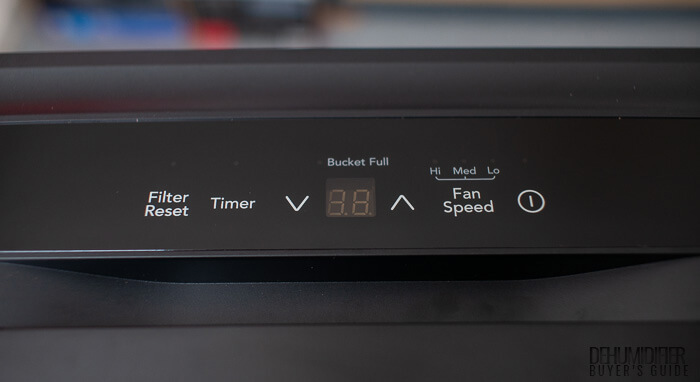
LED Display Clarity
As we mentioned earlier, this unit features a high quality LED display. Several units we tested, including the highly rated hOmeLabs HME020031N, feature a lower quality display.
Setup Difficulty
The FFAD5033W1 couldn’t be simpler to use. Every button that needs a label is properly labeled. Every LED indicator light that needs a label is properly labeled.
Some models, like the BDT50WTB, have a control panel with buttons and LEDs that are not adequately labeled.
Due to this lack of proper labeling, the average user will absolutely have to reference the Black+Decker’s manual to figure out what certain buttons do and what certain LEDs signify. The Frigidaire’s control panel is properly labeled so that those same users will be able to use it without needing to reference its manual.
Filter Removal Difficulty
The FFAD5033W1 has a grille on the back. This grille holds a filter that should be cleaned every few weeks. Most other 50 pint units have a grille/filter combo. It’s easy enough to remove the filter in either scenario.
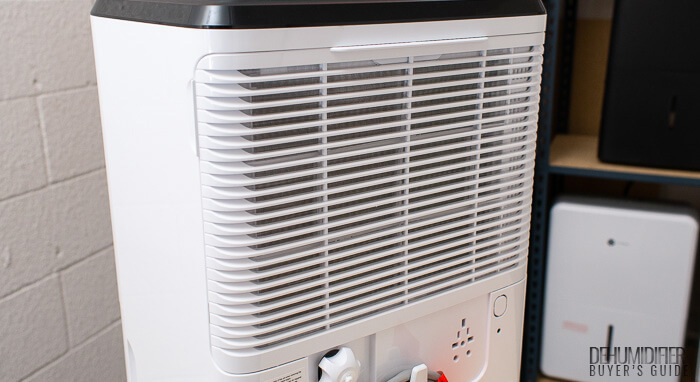
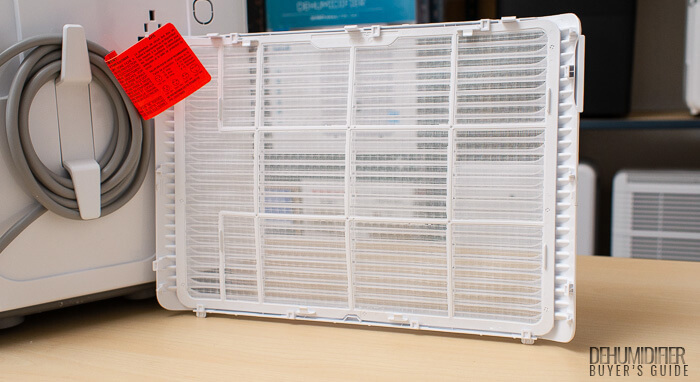
Some units, like the GE ADEL45LY require you to remove the unit’s bucket and then bend down awkwardly to pull down and remove its filter from behind its front panel. Such a unit would receive a lower score in the category.
Manual Clarity
Frigidaire dehumidifier manuals have always been well-written. The same is true for the FFAD5033W1.
Water Tank Size
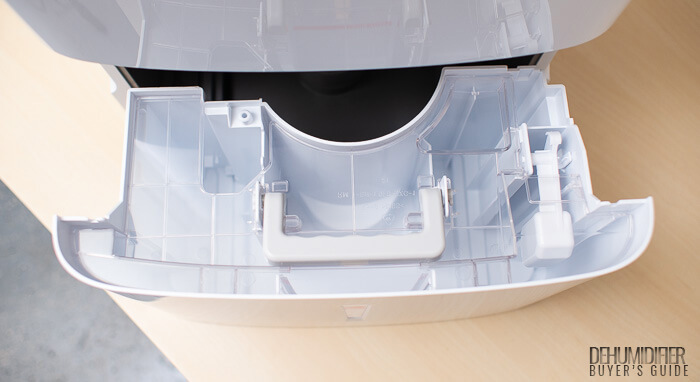
The FFAD5033W1 features a well above average sized water tank. Its capacity is 16.9 pints.
Most other 50 pint units we tested have a water tank with a capacity in the 13 to 14 pint range. The tank capacity for the hOmeLabs is 12.8 pints. For the Black+Decker it’s 14.3 pint. The smallest tank (at the time of this review) belongs to the Danby DDR050BJPWDB. Its tank has a capacity of only 12.6 pints.
Overall Category Score
The Frigidaire FFAD5033W1 is very easy to use and features a very large water tank. It earns a well-deserved 5/5 in the category.
Portability
The FFAD5033W1 weighs 43 lb. This is about average weight for a 50 pint dehumidifier. The hOmeLabs weighs slightly less at 40 lb. The Black+Decker weighs slightly more at 44.5 lb.
The Frigidaire has a top extendable handle that we much prefer over the side pocket handles of the hOmeLabs and Black+Decker. With a top handle you simply reach down and pull up to lift up and carry the dehumidifier. With side pocket handles you have to bend much lower and grab the dehumidifier awkwardly to lift it up and carry it.
The Frigidaire also features excellent cord storage. So do most other 50 pint units we tested, including the hOmeLabs. Only a few 50 pint models, including the Black+Decker BDT50WTB, have no cord storage at all.
Overall Category Score
The FFAD5033W1 earns a 4.5/5 for portability.
Warranty (Manufacturer’s)
The industry standard dehumidifier warranty lasts for only 1 year. The same is true for the warranty included with the Frigidaire FFAD5033W1. This is one of the few negatives for this dehumidifier.
The unit does feature excellent build quality and should last well over 1 year, 2 years, even 3 years and beyond. But we would have liked to see a longer warranty included – a 2 year warranty at a bare minimum.
If warranty length is a priority for you we recommend either the hOmeLabs HME020031N or the Danby DDR050BJPWDB. As of the writing of this review, hOmeLabs will even add an additional 6 months onto the included 2 year warranty for a total warranty length of 2.5 years if you register your product with the manufacturer. Note that the Danby model features a limited “carry in” warranty in which you have to take the unit into an authorized service center for repair.
Value
As of the writing of this review, the Frigidaire FFAD5033W1 has an average to above average price for a 50 pint dehumidifier. That being said, you do “get what you pay for” with this dehumidifier.
Final Thoughts
The Frigidaire FFAD5033W1 is the second best 50 pint dehumidifier we’ve tested. It comes highly recommended if the Midea Cube is out of stock or if you’re looking for a dehumidifier with a more traditional design.
Quick Comparison to Smaller Equivalents
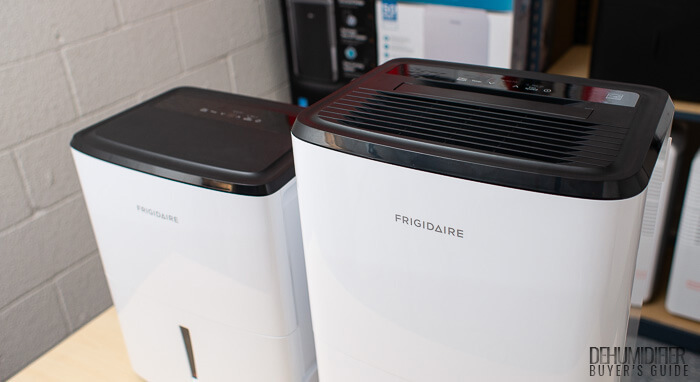
The FFAD3533W1 is the 35 pint equivalent of the FFAD5033W1. The FFAD2233W1 (on the left in the photo above next to the FFAD5033W1) is the 22 pint equivalent. All three units feature an almost identical feature set, build quality, and overall design.
The FFAD3533W1 is a medium capacity dehumidifier. We really don’t think the slight cost savings is worth it for this model compared to the FFAD5033W1.
The FFAD2233W1 is a low capacity dehumidifier. It should only be used in small rooms and/or rooms with moderate to low humidity.